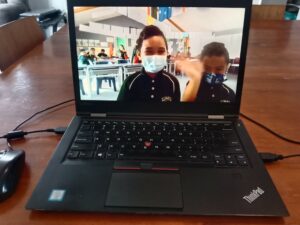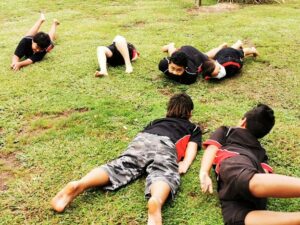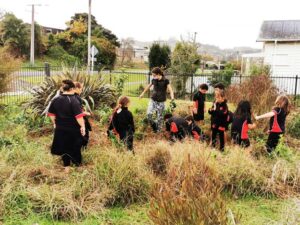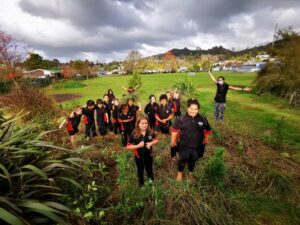Current situation

Students reflected on their learning and shared this with Camilla so that the next session could be planned in a way that supported their ideas.
COVID safety measures implemented over 3 school years impacted on the ability of facilitators to visit schools. For Year 3 students at Pukenui School in Te Kuiti this meant the project they had been preparing for looked like it would be on hold: they had planned to do a ‘Deep Dive’ into understanding and caring for their growing native bush called ‘Te Ara Poutama’. This project was particularly important because they knew the bush faced some challenges (weeds and drying out over the summer months) and they wanted to explore options for sustainable solutions to these challenges. This project was initiated in 2015 by the then senior students when they identified the need for more natural spaces in their school grounds and explored and implemented a ngahere project that reflected local biodiversity and their school values. (See below for 2015 and 2023 comparison images).
Explore alternatives

Worm’s eye view (part of the Enviroschools worms eye view/birds eye view, activity) guided by Camilla via zoom.
Instead of postponing the 2022 Te Ara Poutama learning and action until their Enviroschools Facilitator could come and work with them in person, Lead Teacher, Mrs. Jenny Crown, and Enviroschools Facilitator, Camilla, developed a new approach: while restrictions were in place, they set up a regular time slot and Camilla would Zoom into the classroom, check in with students, introduce the mahi for the week, and students would spend the rest of the day working on it, supported by Mrs. Crown. This process empowered the teacher and ākonga to use the Enviroschools resources to support the learning process. When the activity was completed, students would record their reflections and thoughts (a digital Puna Mātauranga), and the videos would be sent to Camilla. This meant that during preparations for each session, Camilla could factor in student voice from the previous week. Activities were carefully chosen from the Enviroschools resources including Me in My Environment and the Living Landscapes Theme Area, engaging ākonga in sensory walks, habitat assessments and biodiversity investigations, connecting with ngā atua Māori, ‘worms eye view/birds eye view’ and more. Students also started to create a Vision Map during this time, but this proved tricky, so was postponed until in-person visits could resume.

Ākonga carry out a “5 senses walk” activity after talking via zoom.
Take action
When the school opened for visitors again, Camilla was able to meet students in person and learning continued smoothly as relationships were already established (via the Zoom calls). High on the priority list was creating the Vision Map, which became the foundation for the work for the rest of the year. Previous work was also incorporated into and added onto the Vision Map.
However, due to the success of the regular Zoom sessions the plan for the rest of the year was adjusted to incorporate regular online ‘visits’, with in-person sessions as required. The result of this adjustment meant Pukenui School was able to access their facilitator for classroom activities and student interaction as much as they wanted, with fast and efficient online delivery on demand, supported by in-person visits as required.
Reflect on change
The challenge of not being able to visit schools helped Mrs. Crown and Facilitator Camilla come up with an alternative that ended up supporting students in the learning more effectively than expected. It allowed for efficient use of time and resources, while simultaneously enhancing and increasing student engagement with the Enviroschools kaupapa.
Since then, other teachers and classes have shown an interest in utilising the hybrid delivery model for their engagement with Enviroschools. The ability to deliver support and encouragement through a range of mechanisms has allowed ākonga, kaiako and facilitators to genuinely participate and build relationships despite the challenges.

Learning how to do the pūkeko stomp to suppress the weeds around the native planting.

The same place in 2015 as the then students carry out Enviroschools Living Landscapes site assessments and connect with atua Māori to create a vision for Te Ara Poutama.

Celebrating the completion of the pūkeko stomp action with Facilitator, Camilla!

Through their mapping work, Ms Crown discovered that students loved the harakeke bushes in Te Ara Poutama and so she and Camilla explored this more deeply, including inviting students to bring in their harakeke taonga and showing students how to weave and prepare muka.
